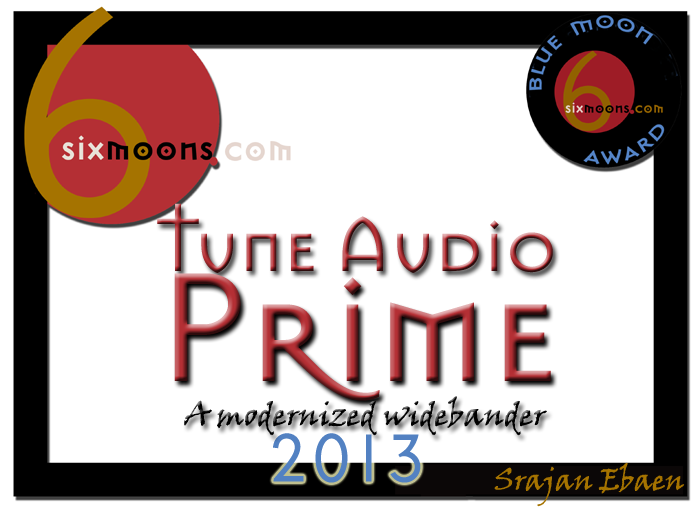This review page is supported in part by the sponsors whose ad banners are displayed below |
 |
 |
The bass Manolis makes from his Fostex is surprising. A robust 35 cycles. A number of competitors could want back to the drawing board. Having heard a number of rear horns 'mouthed' either front or back but not down, their timing tended to be off a bit. This horn's orientation essentially slot loads it with the floor. With the lock wheels of the spikes removed to lower things by about 4mm fully inserted, it generated an element of firm bounce whose springiness matched the central band. With a taller gap I not only had excess amplitude for my room, amps and tastes—this adjustable scheme is as effective as it is with Zu whilst frontal horn mouths are locked in—but the low end ballooned texturally to get too loose and resonant. Even in the best case this bass will never be about the jackhammer dryness and forced staccato violence overdamped alignments produce. Though I personally think the effect unnatural, it has its admirers. But not here. Bass redolence and suppleness mirror the mids for textural continuity. A standard room of 5x7m won't need a subwoofer except for diehard ambient fanatics. They'd need a sub whose low-pass filter was steep enough and went sufficiently low to sneak in without undue overlap.
|
 |
If you've heard live acoustic bass, it's round, big and slightly fat. It's not sinewy like a bouldering body nazi.
It walks on air soles. No clacking steel heels. And that's the Prime. Needless to say, synth-generated bass rises far more steeply than acoustic instruments ever could. If your primary reference is techno, the Prime won't pummel you. It does produce buxom amplitude but lacks the raw cone surface one needs for the gut-punching impact of 12 or 15-caliber slugs - er woofers. On sheer bandwidth and in both directions, the Prime exceeds the original Voxativ Ampeggio I owned. Considering the cost difference of 10G+, that's an achievement. And it's another secret to sounding big. A firm foundation always helps with scale. And the black value of the color palette.
|
|
|
|
|
The question of—and quest for—resolution. By definition resolution should be omniscient and all inclusive. It would cover micro detail, separation of simultaneous events, tone color breadth, timing, dynamic range, dynamic contrast, focus... each and every aspect the vivisectionist approach identifies as discrete qualities. In practice high resolution has become shorthand for a type of aural pixel count. The more minutiae we perceive, the higher we call resolution which makes it so. In those terms accelerated transients, a lit-up presence region and an incisive treble often dominate. In today's genre that would fit a Rethm or Voxativ but not the Prime. On the counts which commonly mean resolution as the ability to render audible the microscopic, our Grecian isn't enormously resolved. My sealed Boenicke B10 with their paralleled 6-octave flat-membrane mid/tweeters made that clear within seconds after swapping back. Ditto dynamic contrast. It's not as keen as 100dB competitors.. Nor shove. Here a Zu Druid V 'resolves' more punch in the power region though it's rather more opaque in the presence band.
That begs the question. What's resolution to you? What do you want magnified?
|
 |
|
| Should your personal thoughts about it feel stronger about tone density, transitional fluidity, scale, coherence, continuousness and the transference of encoded energy or musical charge... then the Prime operates with very high magnification power. It's not about surgical separation. Whilst nothing runs together or blurs, the quality of developed decays creates a type of connective tissue. It's similar to what one so often hears with single-ended triodes. Here it's simply evident already with (premium) transistors. It's directly related to that gushing fluidic pliable gestalt. Big and sumptuous. Lyrical. Those qualities are magnified over against the more typical aspects of analytical hifi discourse. |
|
|
|
|
 |
If you've expected comments on presence region spice, hell shall freeze over sooner. The Prime circumvents the entire issue. That's why high-bandwidth transistor amps with quick reflexes are invited. It's not a high-maintenance widebander. Even the high feedback 25 frisky watts from the $549 gain clone of Hong Kong's Clone Audio gave a compelling showing of themselves. I did luxuriate in my $1000/watt monos but it wasn't essential to release the core flavor. This properly omnivorous rather than exclusionary amplifier appetite is quite practical. Differences remain and the speakers show them off. But you won't miss their fundamental appeal without a hifalutin amp*.
|
|
*Think fast amp. A Job 225 was much preferable to a ModWright KWA-100SE.
|
|
| On basic linearity as the absence of liberties, the Prime plays it perfectly conventional. I'd expect no demerits against for example Von Schweikert's Unifield Three MkII with its 5-inch Fostex widebander augmented by a ribbon tweeter above and a ported 7" magnesium-cone woofer below. Even a 93dB rating has become more conventional. Mainstream brands like Magico and Wilson (the former's Q7 is rated at 94dB, the latter's X2 at 94.5dB) now beat it. Prime's primary distinction is the enormous 35-6.300Hz bandwidth of its main driver which turns de facto point source. But I doubt that the final sound should be pinned on that fact alone. |
|
|
 |
It's down to specific tools a given maker is most comfortable with to create a personal expression of sonic truth. It's never just one thing. Based on what Manolis gets from his Fostex, one simply wonders why so few commercial speakers use it. Fostex seems more popular with DIYers. This raises interesting questions. Suffice it to say here that should this driver be the pedestrian EL84 to the high-brow 300B of AER, Lowther and Voxativ, it's only exposure which can fully appreciate how perception never guarantees better performance. Knowing how to use a tool trumps a tool's shininess, sticker and badge. As the Prime demonstrates, this Fostex deliberately curtailed on high is a very good driver. |
|
Wave 40 vs. Prime. Having lived with the Swiss past its review before it was recalled, I feel comfortable with the following. Energetically the Wave has more forward projection. This manifests as better carrying power into the adjacent space, in my case the open kitchen at the end of the transitional area behind the listening seats. Presumably that's a direct function of its live-vibe tonewood enclosure. Constantly shedding input energies, it operates exactly like a guitar body and is in fact made from identical material. The speaker's size and tuning are good for ~55Hz. Below that the matching Wave 30 subwoofer takes over if desired. By strategically opting against maximal depth mining from its driver, the soundkaos egg produces tighter mid bass with less redolence. The Prime goes after max reach to classify as full-range for a small to normal-sized room. In that it succeeds spectacularly but pays a small price in textural looseness. That's very much like any big-Ø port. A lowered floor gap increases damping but diminishes output and extension (for deep-pile carpet installations you'll ideally let the horn mouth see a smooth hard stone tile to avoid absorption). If you run a sub, use the Prime's cabinet footers and omit all interface hardware altogether.
|
 |
Due to superior extension regardless, the Prime's subjective scale exceeds that of the already very big-sounding wooden eggs. The Wave 40 beats this effect with a subwoofer but obviously this weighs down the price discrepancy yet further. And the Prime could be similarly augmented—though it doesn't require it—and still sell for less than the solo Swiss. The Wave's Raal ribbon eclipses the Fostex compression tweeter in the refinement of tracking gossamer decays from cymbals, triangles and piano and has somewhat wider dispersion. The Wave also has more micro detail magnification.
|
 |
But these differences are brushed under the table by what unites them. Both speakers sacrifice extreme efficiency and concomitant speed to avoid 'front-heavy' attack-centric leanness. Both close down upper treble reach for their widebanders to avoid the Lowther shout. Both add proper tweeters to complete linear extension well beyond where the openly run widebander would go. As a result of such rebellion against the extremist widebander religion, both normalize the breed to increase its appeal. A very real benefit is the allowance of solid-state amplification to which most 100dB widebanders are allergic.
|
|
|
The Prime's normalization of the breed includes conventional appearance because the horn mouth is concealed by the open foot print; and conventional dimensions. Were you a hifi newbie who looking at the rippled driver wouldn't instantly flash Fostex and widebander, there's no visual giveaway that it isn't a perfectly ordinary box. How about audible giveaways? Tricky. The Prime sounds very different from a Voxativ or Rethm. If those were your imprint on the genre, you'd not fully recognize it. Parked next to a superior conventional 7-inch 2-way tower, a dealer demo should show that both soundstage very large but the normie would be more exacting and sorted. Both would cover the same bandwidth with the same linearity.
|
 |
Though its virtual stage wouldn't occupy more space, the Prime would sound bigger and more intense. The normie would feel more mechanical, choppy and studious by lacking the Grecian's peculiar gush. To my ears that's its prime appeal. I'll now reach into my grab bag of cheap tricks—back to a review I did years ago for the Supratek Chardonnay valve preamplifier—to highlight it.
Imagine a shampoo commercial. A beautiful woman turns her head in slow motion. Visualize her perfectly coiffed mane follow that movement like an undulating magic carpet on the breeze. Like a type of advanced tube sound, that temporal nearly suspended elasticity is the Prime's calling card. Besides sounding precociously huge. |
|
|
 |
|
| Wrap. For €6.600/pr, Tune Audio's Prime plumbs the depths like few purely passive genre competitors. It's a horn speaker that doesn't sound it. It's a (treble-augmented) widebander but lacks the usual telltale teeth in the presence zone. It's beautifully continuous in how its core texture operates unbroken bottom to top. This inverted phrasing points at a sound built from the ground up. It's complete by not relying on a sub for normal-sized rooms. It's of special interest to owners of FirstWatt-type transistor amps. Though exotic it's fairly priced. After soundkaos' Wave 40 whose considerably higher price gives it a performance edge albeit not on bandwidth, Manolis Proestakis' Tune Audio Prime now is my second favorite non-widebander widebander. It legitimizes the lone driver with rear horn-loading and higher efficiency by stripping away valid complaints. With that it renews promise and modernizes relevance. An award is in order as is a μόνιμη επευφημία or standing ovation... |
|
|
|
 |
 |
Quality of packing: Very good. The pair arrives in a single big crate which will require storage space.
Reusability of packing: Indefinitely if the inner styrofoam spacers hold up.
Ease of unpacking/repacking: Still a one-man job.
Condition of component received: Flawless.
Completeness of delivery: Perfect.
Human interactions: Very good.
Pricing: Good value.
Final comments & suggestions: The tightest bass comes from placing the speakers straight on the floor without spikes. This however reduces extension and amplitude. Think of the adjustable floor gap as a mechanical bass control. It's effective and very useful to accommodate room size, listener bias and amplifier choice. Unlike ultra-efficient widebanders with a presence-region emphasis or heightened attack sharpness, the Prime happily runs on transistor power. If you choose tubes, you'll probably want at least an 8wpc 300B. The designer owns a FirstWatt F5 so valves are far from required. Of the established widebander brands I've heard, the French/Canadian Ocellia is probably closest though the Prime's better bass makes it far more suitable for electronica than the Ocellia models I've auditioned. Nearly unlimited finish options.
|
 |
 |
|
 |